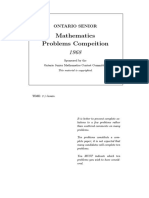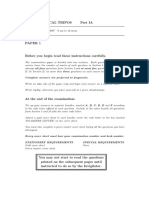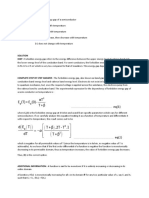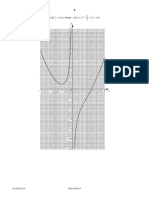The 64th William Lowell Putnam Mathematical Competition Saturday, December 6, 2003
The 64th William Lowell Putnam Mathematical Competition Saturday, December 6, 2003
Uploaded by
Âshútösh KumarCopyright:
Available Formats
The 64th William Lowell Putnam Mathematical Competition Saturday, December 6, 2003
The 64th William Lowell Putnam Mathematical Competition Saturday, December 6, 2003
Uploaded by
Âshútösh KumarOriginal Description:
Original Title
Copyright
Available Formats
Share this document
Did you find this document useful?
Is this content inappropriate?
Copyright:
Available Formats
The 64th William Lowell Putnam Mathematical Competition Saturday, December 6, 2003
The 64th William Lowell Putnam Mathematical Competition Saturday, December 6, 2003
Uploaded by
Âshútösh KumarCopyright:
Available Formats
The 64th William Lowell Putnam Mathematical Competition
Saturday, December 6, 2003
A1 Let n be a fixed positive integer. How many ways are B2 Let n be a positive integer. Starting with the sequence
there to write n as a sum of positive integers, 1, 21 , 31 , . . . , 1n , form a new sequence of n − 1 entries
3 5 2n−1
4 , 12 , . . . , 2n(n−1) by taking the averages of two consec-
n = a1 + a2 + · · · + ak ,
utive entries in the first sequence. Repeat the averaging
with k an arbitrary positive integer and a1 ≤ a2 ≤ · · · ≤ of neighbors on the second sequence to obtain a third
ak ≤ a1 + 1? For example, with n = 4 there are four sequence of n−2 entries, and continue until the final se-
ways: 4, 2+2, 1+1+2, 1+1+1+1. quence produced consists of a single number xn . Show
that xn < 2/n.
A2 Let a1 , a2 , . . . , an and b1 , b2 , . . . , bn be nonnegative real
numbers. Show that B3 Show that for each positive integer n,
n
(a1 a2 · · · an )1/n + (b1 b2 · · · bn )1/n n! = ∏ lcm{1, 2, . . . , bn/ic}.
i=1
≤ [(a1 + b1 )(a2 + b2 ) · · · (an + bn )]1/n .
(Here lcm denotes the least common multiple, and bxc
A3 Find the minimum value of denotes the greatest integer ≤ x.)
| sin x + cos x + tan x + cot x + sec x + csc x| B4 Let f (z) = az4 + bz3 + cz2 + dz + e = a(z − r1 )(z −
r2 )(z − r3 )(z − r4 ) where a, b, c, d, e are integers, a 6= 0.
for real numbers x. Show that if r1 + r2 is a rational number and r1 + r2 6=
r3 + r4 , then r1 r2 is a rational number.
A4 Suppose that a, b, c, A, B,C are real numbers, a 6= 0 and
A 6= 0, such that B5 Let A, B, and C be equidistant points on the circumfer-
ence of a circle of unit radius centered at O, and let P
|ax2 + bx + c| ≤ |Ax2 + Bx +C| be any point in the circle’s interior. Let a, b, c be the
distance from P to A, B,C, respectively. Show that there
for all real numbers x. Show that is a triangle with side lengths a, b, c, and that the area of
this triangle depends only on the distance from P to O.
|b2 − 4ac| ≤ |B2 − 4AC|.
B6 Let f (x) be a continuous real-valued function defined
A5 A Dyck n-path is a lattice path of n upsteps (1, 1) and n on the interval [0, 1]. Show that
downsteps (1, −1) that starts at the origin O and never Z 1Z 1 Z 1
dips below the x-axis. A return is a maximal sequence | f (x) + f (y)| dx dy ≥ | f (x)| dx.
of contiguous downsteps that terminates on the x-axis. 0 0 0
For example, the Dyck 5-path illustrated has two re-
turns, of length 3 and 1 respectively.
Show that there is a one-to-one correspondence be-
tween the Dyck n-paths with no return of even length
and the Dyck (n − 1)-paths.
A6 For a set S of nonnegative integers, let rS (n) denote the
number of ordered pairs (s1 , s2 ) such that s1 ∈ S, s2 ∈ S,
s1 6= s2 , and s1 + s2 = n. Is it possible to partition the
nonnegative integers into two sets A and B in such a way
that rA (n) = rB (n) for all n ?
B1 Do there exist polynomials a(x), b(x), c(y), d(y) such
that
1 + xy + x2 y2 = a(x)c(y) + b(x)d(y)
holds identically?
You might also like
- Aops Community 2007 China Team Selection TestDocument4 pagesAops Community 2007 China Team Selection TestK. M. Junayed AhmedNo ratings yet
- The 57th William Lowell Putnam Mathematical Competition Saturday, December 7, 1996Document1 pageThe 57th William Lowell Putnam Mathematical Competition Saturday, December 7, 1996aditya dwivediNo ratings yet
- 2012 ELMO Shortlist PDFDocument5 pages2012 ELMO Shortlist PDFNadiaNo ratings yet
- Banco Imo 1996 Sem SoluçõesDocument6 pagesBanco Imo 1996 Sem SoluçõesIsrael DouradoNo ratings yet
- Aops Community 1980 Imo ShortlistDocument3 pagesAops Community 1980 Imo ShortlistJoel FerreiraNo ratings yet
- Problems: For The Team Competition Baltic Way 2001Document2 pagesProblems: For The Team Competition Baltic Way 2001Mauricio MallmaNo ratings yet
- Aops Community 2006 China Team Selection TestDocument4 pagesAops Community 2006 China Team Selection TestK. M. Junayed AhmedNo ratings yet
- Aops Community 2001 Bulgaria National OlympiadDocument2 pagesAops Community 2001 Bulgaria National OlympiadА. ТөгсцогтNo ratings yet
- IMO Shortlist 1997Document4 pagesIMO Shortlist 1997quaned2k5No ratings yet
- Inmo DrillDocument2 pagesInmo DrillS-O-U-L GAMINGNo ratings yet
- Undergraduate - Competitions Putnam 2004 23Document2 pagesUndergraduate - Competitions Putnam 2004 23tuoi 16 co emmNo ratings yet
- BW 01 ProblDocument2 pagesBW 01 ProblThai An NguyenNo ratings yet
- 2002 IMO Training Camp: Contributors: Sayan, Orl, Valentin Vornicu, Darij GrinbergDocument3 pages2002 IMO Training Camp: Contributors: Sayan, Orl, Valentin Vornicu, Darij GrinbergHariPrasad PoilathNo ratings yet
- Aops Community 2008 China Team Selection TestDocument4 pagesAops Community 2008 China Team Selection TestK. M. Junayed AhmedNo ratings yet
- PUTNAM 1998-ProblemsDocument1 pagePUTNAM 1998-ProblemsRogerNo ratings yet
- IMO Shortlist 1995: AlgebraDocument6 pagesIMO Shortlist 1995: Algebraquaned2k5No ratings yet
- 2003 Step 1Document6 pages2003 Step 1tobysmith26922692No ratings yet
- The 62nd William Lowell Putnam Mathematical Competition Saturday, December 1, 2001Document1 pageThe 62nd William Lowell Putnam Mathematical Competition Saturday, December 1, 2001fbfbdsfusd sdufuNo ratings yet
- 2010 ELMO ShortlistDocument4 pages2010 ELMO ShortlistKanchit Saeho0% (1)
- IMO Shortlist 1998: AlgebraDocument6 pagesIMO Shortlist 1998: Algebraquaned2k5No ratings yet
- 2012 ELMO Modified ShortlistDocument6 pages2012 ELMO Modified ShortlistHuỳnh Thúc ĐẩyNo ratings yet
- IMO Shortlist 1991Document4 pagesIMO Shortlist 1991quaned2k5No ratings yet
- IMO Shortlist 1996: AlgebraDocument7 pagesIMO Shortlist 1996: Algebraquaned2k5No ratings yet
- IMO Questions Part 2 (1970-1979)Document15 pagesIMO Questions Part 2 (1970-1979)digitalpapers100% (1)
- Aops Community 2016 Baltic WayDocument3 pagesAops Community 2016 Baltic WayMd HajjulNo ratings yet
- BabinZub2006 AiDocument5 pagesBabinZub2006 AiPingvin AnarhistaNo ratings yet
- Aops Community 2013 Imo ShortlistDocument5 pagesAops Community 2013 Imo Shortlistjohan NGONTIENo ratings yet
- Aops Community 2013 China Team Selection TestDocument3 pagesAops Community 2013 China Team Selection Testydyane3dNo ratings yet
- 7t5SDnH4fkikkaJWE LWNWDocument13 pages7t5SDnH4fkikkaJWE LWNWLong NguyễnNo ratings yet
- 2015 Mock AIME II: Henrik Boecken Et Al. March 12, 2015Document3 pages2015 Mock AIME II: Henrik Boecken Et Al. March 12, 2015bhumit bamelNo ratings yet
- Mathematics Problems Compeition: Ontario SeniorDocument4 pagesMathematics Problems Compeition: Ontario Senioranon_415025355No ratings yet
- KMO JuniorDocument2 pagesKMO JuniorLeon FoneNo ratings yet
- 2012 ELMO Modified ShortlistDocument6 pages2012 ELMO Modified Shortlistjell0boyNo ratings yet
- The 74th William Lowell Putnam Mathematical Competition Saturday, December 7, 2013Document2 pagesThe 74th William Lowell Putnam Mathematical Competition Saturday, December 7, 2013Ignacio MartinezNo ratings yet
- Baltic Way 2011Document3 pagesBaltic Way 2011georgeNo ratings yet
- IMO Shortlist 1993: AlgebraDocument8 pagesIMO Shortlist 1993: Algebraquaned2k5No ratings yet
- 2012 NIMO Problems: Contributors: AIME15, V EnhanceDocument12 pages2012 NIMO Problems: Contributors: AIME15, V EnhanceLulu Arifatun MunasirohNo ratings yet
- Aops Community 2014 Indonesia Mo Shortlist: Inamo Osn Shortist 2014Document3 pagesAops Community 2014 Indonesia Mo Shortlist: Inamo Osn Shortist 2014JeffersonNo ratings yet
- 2004 India IMO Training CampDocument5 pages2004 India IMO Training CampHariPrasad PoilathNo ratings yet
- IMO Longlist 1982 ProblemsDocument8 pagesIMO Longlist 1982 ProblemsTrung ĐứcNo ratings yet
- Zuming Feng - MOSP 2 007 - Mathematical Olympiad Summer Program Tests - 21p - Sólo Problemas - Mosptests PDFDocument21 pagesZuming Feng - MOSP 2 007 - Mathematical Olympiad Summer Program Tests - 21p - Sólo Problemas - Mosptests PDFElliot100% (2)
- Training EasyputDocument18 pagesTraining EasyputAvinash RayNo ratings yet
- IMO 1976 LongListDocument5 pagesIMO 1976 LongListMinh BuiNo ratings yet
- Austria Regional 2006Document1 pageAustria Regional 2006Karn KumarNo ratings yet
- 2022 AimeDocument6 pages2022 AimechuckNo ratings yet
- The 71st William Lowell Putnam Mathematical Competition Saturday, December 4, 2010Document1 pageThe 71st William Lowell Putnam Mathematical Competition Saturday, December 4, 2010matrix dNo ratings yet
- 2007 PaperIA - 1Document7 pages2007 PaperIA - 1Ross WrightNo ratings yet
- f01 Basic AdvcalcDocument2 pagesf01 Basic AdvcalcshottyslingNo ratings yet
- Aops Community 1967 Imo LonglistsDocument8 pagesAops Community 1967 Imo Longlistsarshijoh1368754No ratings yet
- Aops Community 2019 India Regional Mathematical OlympiadDocument2 pagesAops Community 2019 India Regional Mathematical OlympiadKambing HitamNo ratings yet
- IMO Longlist 1985 ProblemsDocument12 pagesIMO Longlist 1985 ProblemsTrung ĐứcNo ratings yet
- The 82nd William Lowell Putnam Mathematical Competition Saturday, December 4, 2021Document1 pageThe 82nd William Lowell Putnam Mathematical Competition Saturday, December 4, 2021Pătularu andreiNo ratings yet
- Enumeration 2023 Prelims SolDocument19 pagesEnumeration 2023 Prelims SolEvariste MigaboNo ratings yet
- The 77th William Lowell Putnam Mathematical Competition Saturday, December 3, 2016Document1 pageThe 77th William Lowell Putnam Mathematical Competition Saturday, December 3, 2016Ramneek SinghNo ratings yet
- Buffet Contest - X - Canada 2010Document2 pagesBuffet Contest - X - Canada 2010Ayush AryanNo ratings yet
- USA Math Prize For Girls 2011 218 PDFDocument3 pagesUSA Math Prize For Girls 2011 218 PDFDarapiseth ChhunNo ratings yet
- BW 07 PBDocument2 pagesBW 07 PBThai An NguyenNo ratings yet
- Pmo 2016 AreaDocument3 pagesPmo 2016 AreaKarl Henry DahaoNo ratings yet
- International - Competitions IMO - Shortlist 1969 17Document7 pagesInternational - Competitions IMO - Shortlist 1969 17ferrousweiNo ratings yet
- The 68th William Lowell Putnam Mathematical Competition Saturday, December 1, 2007Document1 pageThe 68th William Lowell Putnam Mathematical Competition Saturday, December 1, 2007Âshútösh KumarNo ratings yet
- Solution 2 Vernier CalliperDocument2 pagesSolution 2 Vernier CalliperÂshútösh KumarNo ratings yet
- Solution 1 SemiconductorDocument2 pagesSolution 1 SemiconductorÂshútösh KumarNo ratings yet
- 2 L SBYkb J3 ATsabyqsw 5 ZDocument14 pages2 L SBYkb J3 ATsabyqsw 5 ZÂshútösh KumarNo ratings yet
- SBEC-NMEC Unit1Document26 pagesSBEC-NMEC Unit1Austin RebbyNo ratings yet
- Permutation & Combination-04-ExerciseDocument13 pagesPermutation & Combination-04-ExerciseRaju SinghNo ratings yet
- A Practical Guide To SplineDocument8 pagesA Practical Guide To SplineDavid PomaNo ratings yet
- Classical Mechanics Notes (4 of 10)Document30 pagesClassical Mechanics Notes (4 of 10)OmegaUserNo ratings yet
- Chapter 1 Crystal StructureDocument6 pagesChapter 1 Crystal StructurelastlegendNo ratings yet
- HW 15 SolnDocument2 pagesHW 15 SolnPhương LêNo ratings yet
- MATH1002 Linear Algebra: Dinh T. Tran Teaching Period: Weeks 1-13 Office Hour: TBADocument17 pagesMATH1002 Linear Algebra: Dinh T. Tran Teaching Period: Weeks 1-13 Office Hour: TBALucille MelbourneNo ratings yet
- Exceptional Periodicity and Magic Star Algebras. I: FoundationsDocument18 pagesExceptional Periodicity and Magic Star Algebras. I: FoundationsQuantum Gravity ResearchNo ratings yet
- AE 5332 - Professor Dora Elia Musielak: Residue Theorem and Solution of Real Indefinite IntegralsDocument13 pagesAE 5332 - Professor Dora Elia Musielak: Residue Theorem and Solution of Real Indefinite IntegralsJohnNo ratings yet
- ME 1501 Computer Aided Design 2020 Odd Semster Tutorial Sheet No. 1Document1 pageME 1501 Computer Aided Design 2020 Odd Semster Tutorial Sheet No. 1Prateek ShivhareNo ratings yet
- A Note On Fourier Series of Half Wave ReDocument8 pagesA Note On Fourier Series of Half Wave ReRocker byNo ratings yet
- 6.1 - Radian Measure and Arc Length Math 30-1Document14 pages6.1 - Radian Measure and Arc Length Math 30-1Math 30-1 EDGE Study Guide Workbook - by RTD LearningNo ratings yet
- Math 2400 First Midterm Exam: Pete L. ClarkDocument2 pagesMath 2400 First Midterm Exam: Pete L. ClarkGary SynthosNo ratings yet
- Differentiation and Its Application: 2.1 Differentiability of A FunctionDocument18 pagesDifferentiation and Its Application: 2.1 Differentiability of A FunctionAnemesh BaruaNo ratings yet
- Unit 10 P4 PPQs 2.2QsDocument10 pagesUnit 10 P4 PPQs 2.2Qswaltuh.feher.methNo ratings yet
- Linear Algebra MAT223 Instructor's Guide by Jason SiefkenDocument108 pagesLinear Algebra MAT223 Instructor's Guide by Jason SiefkenDr M R YadavNo ratings yet
- A Gronwall Inequality and Its Applications ToDocument35 pagesA Gronwall Inequality and Its Applications ToMinzilya -Svetlana KosmakovaNo ratings yet
- The Dot Product & The Cross ProductDocument53 pagesThe Dot Product & The Cross ProductgershaterNo ratings yet
- Cauchy Goursat Theorem Section 6.4Document7 pagesCauchy Goursat Theorem Section 6.4Moisa VicaNo ratings yet
- B.SC - Honours-Physics PDFDocument101 pagesB.SC - Honours-Physics PDFRaman BhullarNo ratings yet
- Ma MathematicsDocument2 pagesMa MathematicsAllan Said BNo ratings yet
- Linear Algebra With Applications-Pearson Education Limited (2013 - 2014)Document15 pagesLinear Algebra With Applications-Pearson Education Limited (2013 - 2014)Phưong Ngô Thị XuânNo ratings yet
- Multivariable Calculus: Math 215.70 Winter 2003Document9 pagesMultivariable Calculus: Math 215.70 Winter 2003Doris riverosNo ratings yet
- Problem Set On Hyperbolic FunctionDocument4 pagesProblem Set On Hyperbolic FunctionEDWINNo ratings yet
- Tut1-Vector Analysis (Proplem Set1)Document5 pagesTut1-Vector Analysis (Proplem Set1)Ty PhanNo ratings yet
- 7th STD Term 1 Mathematics EM PDFDocument136 pages7th STD Term 1 Mathematics EM PDFSusanNo ratings yet
- Plane Trigonometry: Trigonometry Angle Unit ConversionDocument5 pagesPlane Trigonometry: Trigonometry Angle Unit ConversionZairah Ann BorjaNo ratings yet
- A. Identify The Center and Radius of Each. Then Sketch The Graph. 1. 2.Document9 pagesA. Identify The Center and Radius of Each. Then Sketch The Graph. 1. 2.Wendelyn Sumpo100% (1)
- Differential Equations NoteDocument25 pagesDifferential Equations NoteSumudu DilshanNo ratings yet
- Lab 1Document4 pagesLab 1Deepak MishraNo ratings yet





























































































